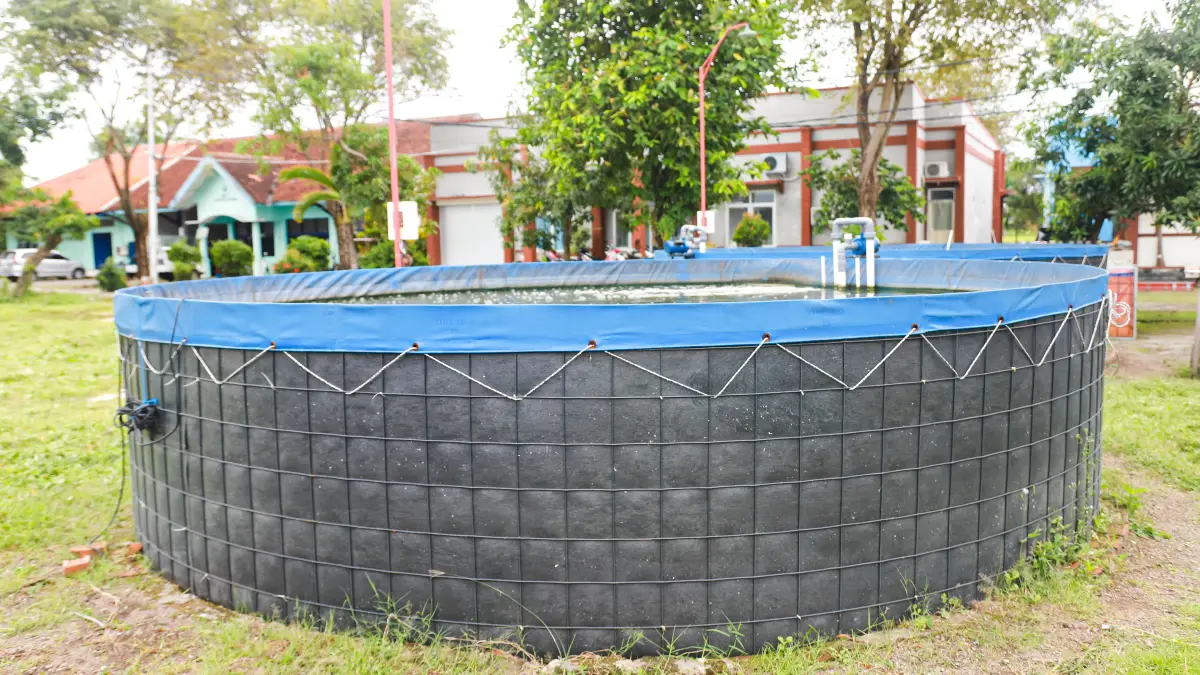When it’s 35 °C (95 °F) and your yard bakes, a compact stock tank can turn a 3×3 m corner into a cold-plunge oasis—often in a single weekend. But most DIY posts gloss over the deal-breakers: safe electrics around water, what chlorine does to metal, how to keep pH in range without wrecking the tank, and how to stop mosquitoes before they turn your “pool” into a science experiment.
This guide fixes that. You’ll learn how to choose galvanized vs poly (and why many 2025 builders go poly), size the tank for soaking vs lounging, build a dead-level base, and plumb a real filter pump so the water actually clears. We’ll show you how to keep free chlorine and pH in the ranges recommended by the Centers for Disease Control and Prevention (CDC), how to add a cover or compact heater, and how to layer on design touches that look intentional, not improvised.
You’ll also see the latest safety must-knows—GFCI protection per the 2023 electrical code, CDC-backed drowning-prevention reminders, and what the 2025 above-ground-pool recall teaches all small-pool owners about removing footholds and securing access.
Choose Your Tank: Galvanized vs Poly
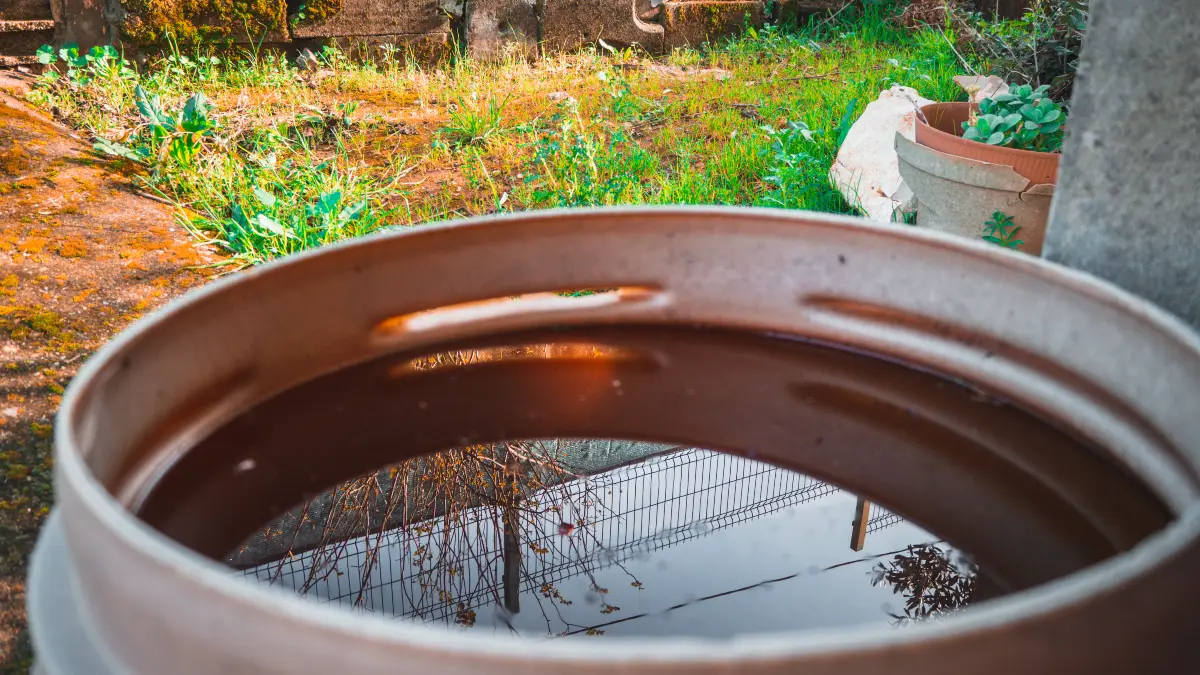
Smart Tank Picking—Data to Decide Fast
Evidence highlights from CDC • American Galvanizers Association • Manufacturer specs
If you want low-fuss chlorine use → Poly
- Non-corroding LDPE/structural foam—friendly with standard pool chemistry (CDC ranges).
- Molded drain simplifies winterizing and water changes.
- Rigid lip tolerates through-wall fittings for a real filter loop.
If you love the metal look → Galvanized
- Inside pool water is not a typical HDG use (American Galvanizers Association).
- Chlorine increases zinc attack—expect liner/epoxy + touch-ups.
- Heavier pad, bigger pump/filter, and fencing budget.
Chemistry Facts That Save You Money
- CDC pool targets: Free chlorine ≥ 1 ppm (≥ 2 ppm with cyanuric acid); pH 7.0–7.8. Test daily in heat.
- Metal note: Elevated chlorine and higher temperature accelerate zinc corrosion—keep metal-lined tanks at the low end of effective chlorine and rinse after use.
- Biofilm reality: Wipe/brush 1–2× per week; thin films protect algae even when chlorine reads “OK.”
“Hot-dip galvanized surfaces immersed in chlorinated pool water are not a typical application.” — American Galvanizers Association (technical guidance)
Right-Size the Tank (Weight • Fill • Footprint)
| Use Case | Common Size | Water Weight | Fill Time | Footprint |
|---|---|---|---|---|
| Cold plunge / solo soak | 100–110 gal oval | ~834–917 lb | 12–18 min | ≈53″ × 36″ |
| Lounging with friends | 8′ round (~700 gal) | ~5,838 lb | 78–117 min | 8′ Ø (24″ tall) |
Plumbing-Ready Features That Matter
- Oversized drain (≈1½″) on structural-foam tanks speeds seasonal emptying.
- Stiff rim tolerates bulkheads and ball/plunger valves for a real filter loop.
- Smooth interior wall makes gasket seals reliable and reduces algae grip.
90-Second Decision
Choose Poly if you want:
- Chlorine in CDC range with minimal corrosion risk.
- Faster setup and easier winterizing.
- Lighter tank handling.
Choose Galvanized only if you’ll:
- Apply liner/epoxy and monitor chlorine closely.
- Accept touch-ups and higher upkeep.
- Budget for a stronger base, fence, and larger pump/filter.
The quick answer: Pick poly (LDPE/structural foam) if you want the lowest-maintenance, chlorine-friendly setup. Choose galvanized steel only if you love the look and you’re willing to line, coat, and maintain it more aggressively.
Why poly wins for pools: Polyethylene stock tanks (e.g., Tuff Stuff’s ~110-gal oval) are UV-resistant, non-corroding, and light enough to maneuver, with molded drains that make seasonal emptying simple. Rubbermaid’s structural-foam tanks (commonly 100 gal) include an oversized ~1½-inch drain and a rigid lip that tolerates through-wall fittings for pump plumbing. These features translate to faster setup, easier winterizing, and fewer chemistry-related headaches. (Product specs: Tuff Stuff ~110 gal LDPE with drain; Rubbermaid structural-foam 100 gal with large drain.)
The galvanized catch: Chlorinated water accelerates corrosion of zinc. The American Galvanizers Association notes that immersing hot-dip-galvanized (HDG) steel inside pool water is “not a typical application,” and higher chlorine levels drive faster attack. If you insist on metal, plan for a high-solids epoxy/liner, keep free chlorine at the low end of the CDC’s effective range, rinse after use, and expect touch-ups over time.
Sizes and shapes: For cold-plunge/soak, the common 100–110 gal ovals (roughly ~53″ × 36″ × 20″) are ideal: quick to fill, cheap to heat/cool, and easy to manage. If you want to lounge with friends, the classic 8-ft round galvanized tank (~700 gal, ~24″ tall) is the social pick—just budget for a beefier pad, fencing/barrier, and a higher-capacity pump/filter.
Location & Base: Level, Drainable, Code-Smart
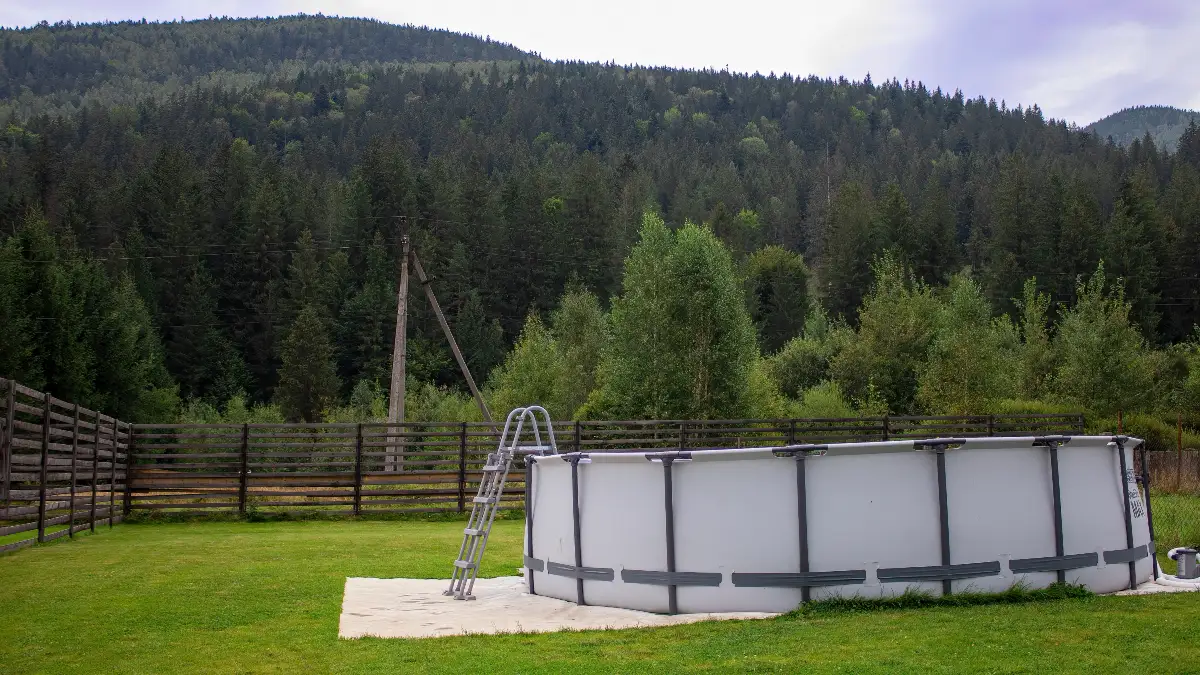
Get the base right, or fix it later with a siphon. Build a perfectly level pad using compacted gravel topped with a thin sand screed or lay large pavers on a compacted sub-base. A level rim keeps water load even, prevents seam stress, and makes skimming actually work.
Plan the power safely. For your stock tank pool pump, site the tank so the pump’s cord can reach a ground-fault circuit interrupter (GFCI)-protected receptacle without extension cords. The 2023 National Electrical Code (NEC) Article 680 clarifies that pool pump motors must be GFCI-protected; when a pump is replaced or serviced, the installation must include GFCI protection. In practice: have a licensed electrician install a code-compliant GFCI receptacle/circuit and bond any required metal parts. Keep outlets at proper distance/height and follow your local amendments.
Think supervision and runoff. Keep clear sightlines from the house to the pool; avoid placing the tank behind screens or vegetation that blocks views. The CDC reminds homeowners that drowning remains a leading cause of unintentional injury death; barriers, active supervision, and removing climbable items near the pool dramatically reduce risk. Grade the pad to shed splash water away from foundations and muddy spots.
Plumbing & Pump/Filter Setup That Actually Works
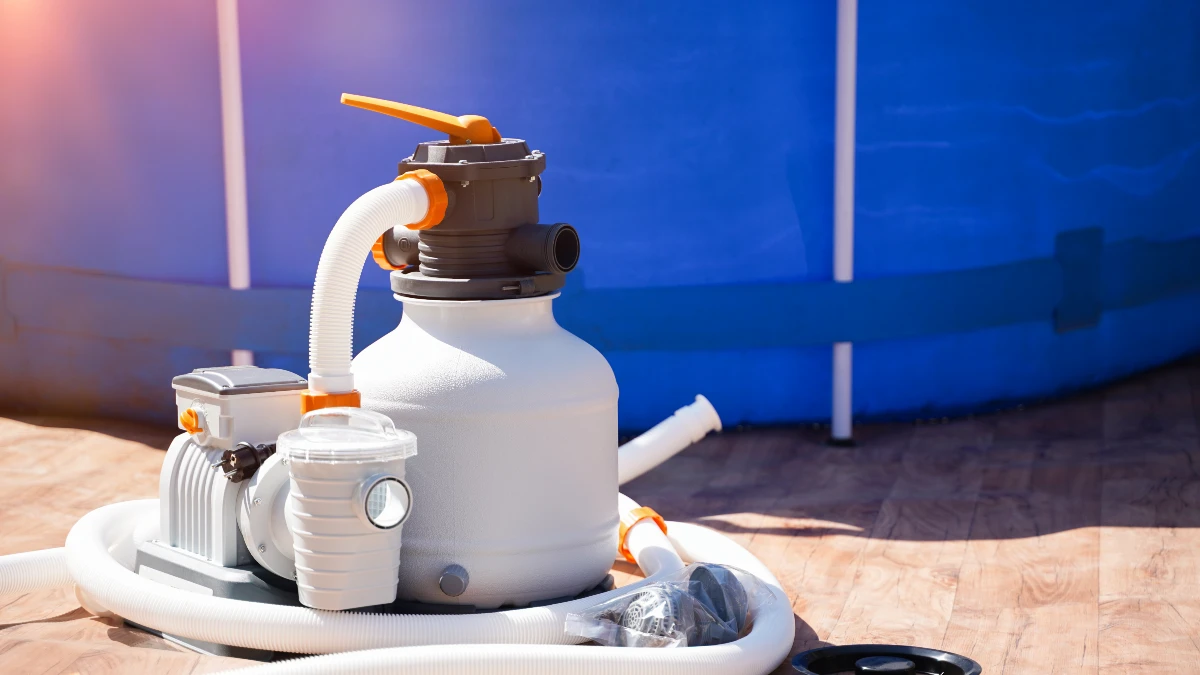
Target real turnover. A cartridge filter pump rated 1,000–1,500 GPH easily turns over a 100–110 gal plunge tank many times per hour, which keeps water clear and chemicals effective. Intex’s current Krystal Clear units list 1,000 GPH (system ~750 GPH) and 1,500 GPH (turnover ~1,180 GPH) with 1.25″ hose fittings and built-in GFCI cords—ideal for small tanks; step up to a compact sand filter if you regularly host groups or run a larger (8-ft) tank.
Penetrations that don’t leak. Mark an inlet low (to pull settled debris) and an outlet high (for good circulation). Use a 2 ¾″ hole saw sized to your bulkheads, and sandwich the wall with gaskets + marine-grade sealant before tightening. Add ball valves (or Intex plunger valves) so you can service the filter without draining the pool. Keep the factory drain plug accessible for seasonal emptying or vacuuming to waste.
Hoses and adapters that fit the first time. Most entry pumps use 1.25″ hoses; your bulkheads or skimmer may be 1.5″. Use the proper hose adapters (Intex publishes adapter SKUs) and stainless hose clamps. Keep hose runs short and gentle to reduce head loss.
Skimmer & debris control. If space allows, add a through-wall skimmer or surface skimmer basket on the suction side; it’ll catch leaves before they clog the cartridge and dramatically improve clarity.
Proven installs to model. For visuals, look for recent (2024–2025) YouTube builds that show drilling locations, bulkhead orientation, and pump hookups step-by-step—use them as a sanity check before you cut.
Water Chemistry: Simple, CDC-Aligned Targets
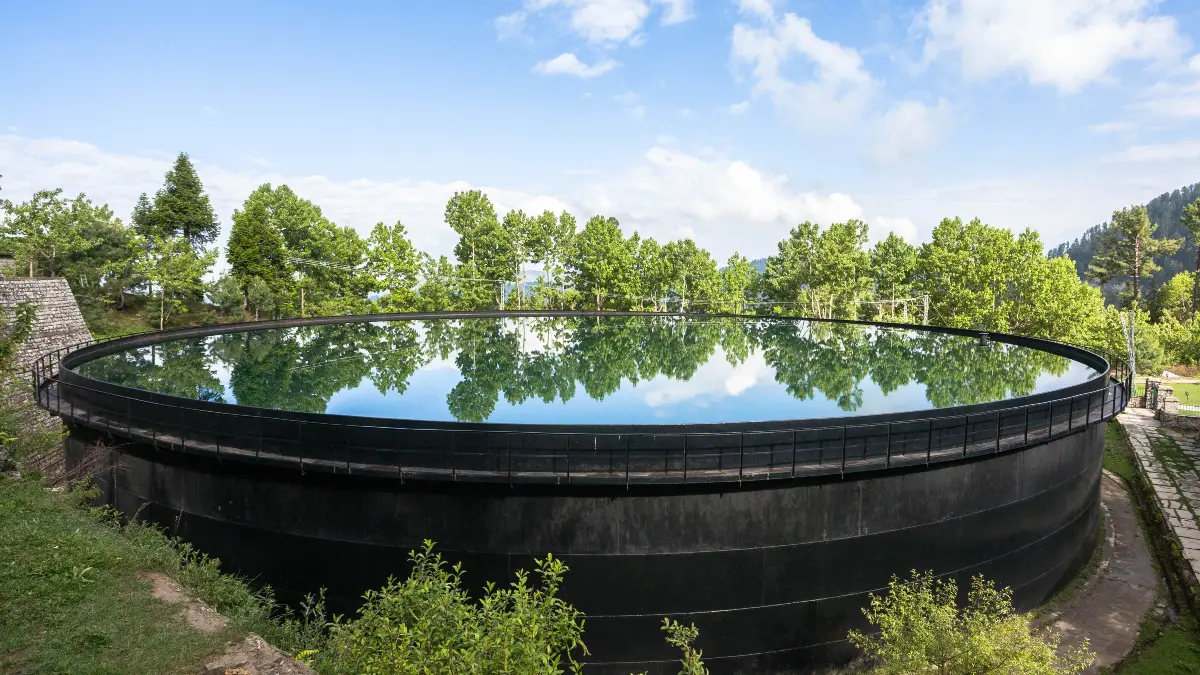
Clear water is the result of consistent targets and simple habits. For a small plunge, aim for free chlorine ≥1 ppm (raise to ≥2 ppm if you use stabilizer/cyanuric acid) and pH 7.0–7.8—those are the ranges the Centers for Disease Control and Prevention (CDC) recommends for home pools. Test daily during heatwaves or heavy use; every other day is fine when temps cool or bather load is light.
Use a basic liquid test kit for free chlorine and pH (strips are fine for quick checks, but liquid kits are more precise). Dose in small increments, wait 30 minutes with the stock tank pool pump running, then re-test before adding more. If you’re using cyanuric acid (CYA) via tabs or granular stabilizer, keep CYA low to moderate in these tiny volumes—high CYA slows chlorine’s germ-killing power, which is counterproductive in warm water.
Adopt a weekly rhythm: after parties or high use, shock (raise free chlorine temporarily), run the pump longer, and clean the cartridge. Brush or wipe the walls and floor 1–2×/week—even poly tanks develop a thin biofilm that shields algae if left alone. Empty the skimmer basket often; fine debris consumes chlorine.
Special note for galvanized steel: chlorine is tough on zinc. The American Galvanizers Association cautions that immersing hot-dip-galvanized steel in pool water is not a typical application and high chlorine can drive rapid corrosion. If you choose metal for the look, plan on a liner/epoxy, keep chlorine at the low end of the effective range, rinse after use when possible, and expect periodic touch-ups. Clouding or gray staining often signals zinc interacting with sanitizer.
Safety First: Drowning Prevention & Recent Recalls
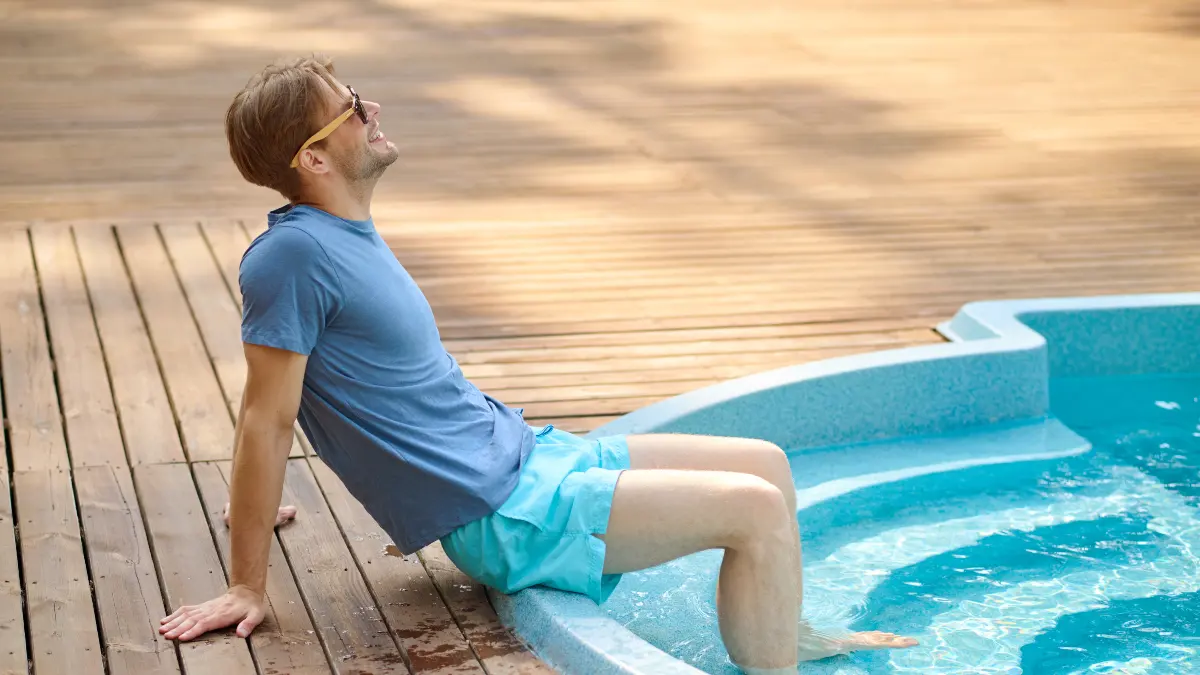
“Small” does not mean “safe enough.” Drowning deaths rose to roughly 4,500 per year in the U.S. from 2020–2022, about 500 more annually than in 2019, according to the CDC’s Vital Signs report. That makes active supervision and physical barriers non-negotiable, even for portable pools.
Follow the U.S. Consumer Product Safety Commission (CPSC) playbook: designate a rotating Water Watcher (no phone, no alcohol), install layers of protection—self-closing, self-latching gates; door and gate alarms; a sturdy cover when the pool is not in use—and learn CPR. Keep furniture and climbable objects away from the pool wall to prevent unsupervised entry.
A 2025 recall underscores why eliminating footholds matters. In July 2025, about 5 million above-ground pools were recalled after nine toddler drownings were linked to external compression straps that acted as footholds, allowing children to climb in. While stock tank pools weren’t part of this action, the lesson is universal: remove footholds, use compliant barriers, and secure access any time the pool is unattended.
For context when writing your child-safety callout: the CPSC’s 2024 Pool or Spa Submersion report details fatal and emergency-department-treated nonfatal drownings among children under 15 and reinforces the role of layers of protection. Pull a single statistic (e.g., share of incidents involving children under five) to anchor the checklist.
Mosquito & Debris Control for Tiny Pools
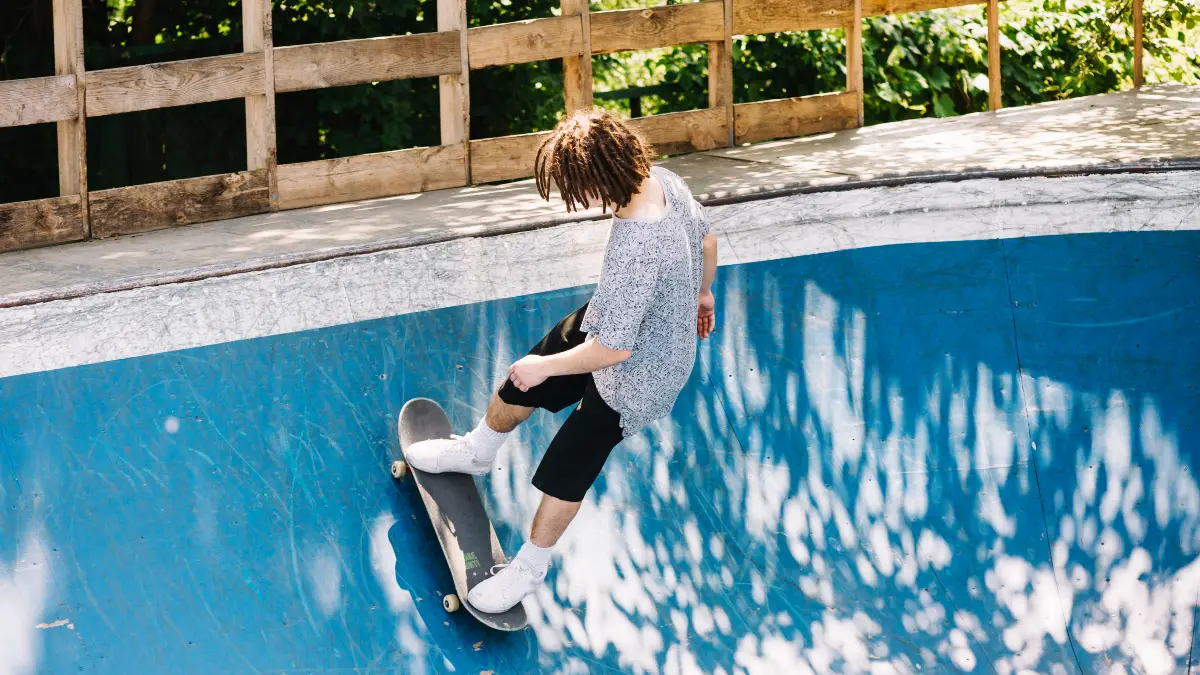
No standing water is rule one. Keep water circulating daily and snap on a tight cover whenever you’re not swimming. Patrol your yard after rain—dump saucers, toys, and buckets. The EPA notes that Bti (Bacillus thuringiensis israelensis) targets mosquito larvae in standing water and is widely used in containers and low spots; it’s not something you add to your swim water but is helpful in non-swim catch basins like rain barrels or that muddy corner that won’t drain.
Lifestyle publications in 2025 (e.g., Southern Living) echo the eliminate-standing-water + use Bti where you can’t drain approach, and many local vector-control programs publish the same advice: use Bti in contained stagnant water, not in flowing water or your active pool. Add a surface “bubbler” or schedule your pump to break surface tension during peak mosquito hours; larvae need still water to breathe.
Finish each swim with a 60-second skim, empty the skimmer basket, and rinse the cartridge if pressure rises. Covers also block leaves and pollen, which otherwise eat up sanitizer and promote slime.
Heating, Cooling & Year-Round Use
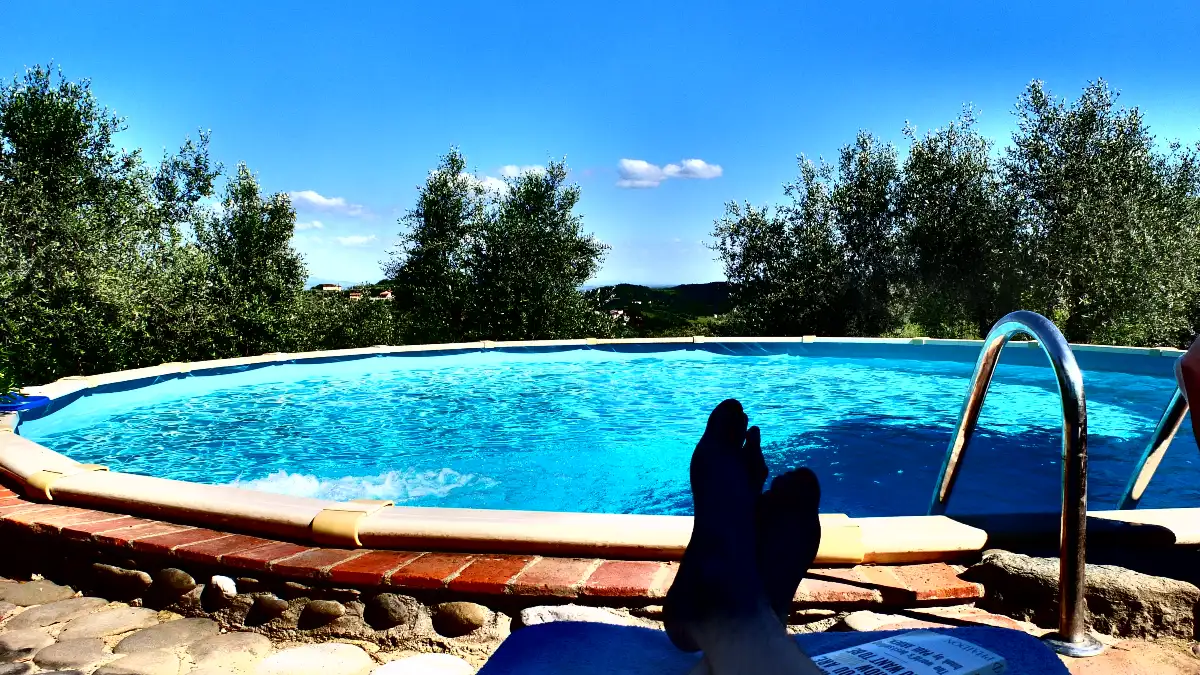
To extend the season, start with a solar cover (dramatic heat retention overnight) and, if you want more control, add a compact heat pump sized for small volumes. For cold-plunge mode, aim for 10–15 °C water; place the tank in partial shade, run the pump in the cool evening, and always lid it at night to hold your target. A simple ice-assist on party days is realistic in 100–110 gal tanks.
If you plan to run hot-tub temperatures, choose poly. The American Galvanizers Association points out that galvanizing immersed in chlorinated pool water is not a typical application and can corrode quickly—hotter water plus chlorine accelerates that. Metal can work if lined or epoxy-coated and carefully maintained, but poly is the practical option for heated, chlorinated setups.
Design & Landscaping Ideas
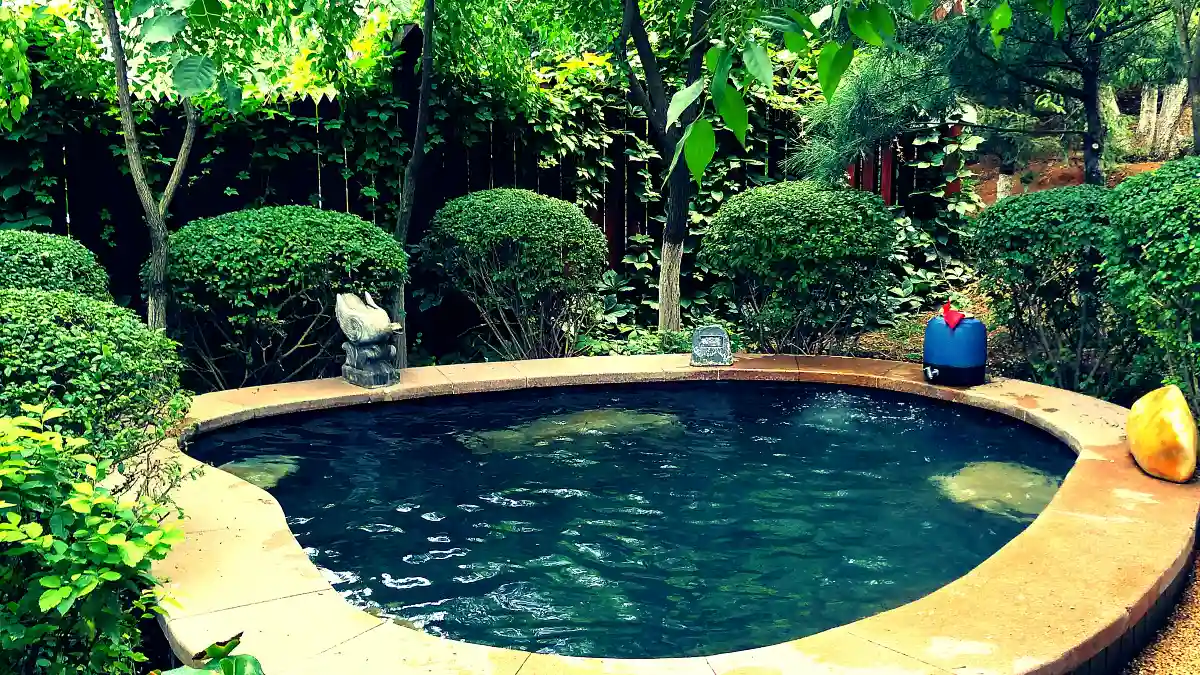
Function first, then style. Build your ideas around a level platform with good circulation, then layer the look.
Deck recess or platform: Set the tank flush with pavers or into a low wood platform so entry feels intentional. Add clip-on rim padding (closed-cell) for comfort and to protect elbows. Keep a clear maintenance aisle on the pump side for filter swaps and valve access.
Shade + privacy: Freestanding umbrellas, slatted screens, and string lights frame a small footprint beautifully. 2024–2025 idea roundups from The Spruce showcase ovals tucked into gravel courts, tanks painted to blend with fences, and clever privacy screens that still allow airflow—great templates you can adapt.
Finishes that last: If you’re painting metal, use a galvanized-safe etch/primer plus a UV-stable topcoat and expect periodic touch-ups. For poly, consider leaving it unpainted (best durability) or use an exterior-rated coating on the outside only; avoid coatings on wetted interiors. Keep the stock tank pool ideas gallery inspiration as decor cues, not technical rules.
Lighting & night use: Low-glare bollard solar lights or 12V landscape LEDs (on a GFCI-protected circuit) create ambience and safer footing. Avoid plug-in string lights over the water.
Covers that work: A soft rolling cover sized to your tank or a light DIY plywood cap with handholds cuts evaporation and debris. If you recess into decking, design a lift-off lid that clears the rim and stores vertically.
Round out the section by linking a mood board: three looks—modern deck, tropical nook, tiny patio plunge—drawing from 2025 Pinterest boards to validate color palettes, plant choices, and screen ideas your reader can copy in an afternoon.
Budget, Tools & Shopping List
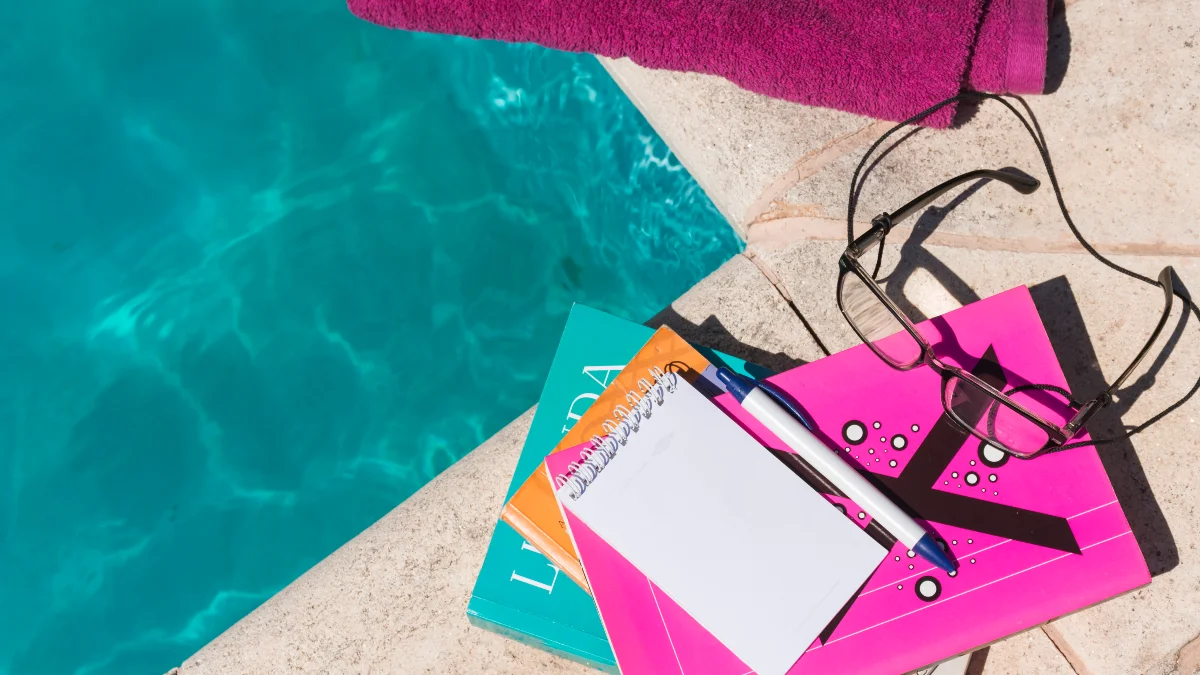
Core kit (works for 100–110 gal poly):
- Tank: 110-gal oval poly (≈ 53″ L × 36″ W × 20″ H).
- Pump/filter: Intex Krystal Clear 1,000–1,500 GPH cartridge unit with GFCI cord.
- Plumbing: 1.25–1.5″ hoses, bulkhead fittings, ball/plunger valves, stainless clamps.
- Water care: test kit, liquid chlorine or tabs, pH up/down, CYA (optional/low), non-foaming algaecide (optional).
- Maintenance: skimmer net/basket, brush, soft cover.
Upgrades (nice-to-have):
- Through-wall skimmer kit (clearer surface).
- Sand filter if you host often or scale up tank size.
- Heat pump or solar cover for shoulder seasons.
- Deck blocks/pavers for a faster, level base.
- Drain plug kit (Rubbermaid/Tuff Stuff spares) for easy service.
When you reference products in the article, point to neutral spec pages (e.g., manufacturer or retailer product pages) rather than affiliate links to keep trust high. This keeps the focus on stock tank pool kit choices, correct stock tank pool pump size, and a transparent DIY plunge pool cost estimate.
Conclusion
With the right material, a GFCI-protected pump, CDC-aligned chemistry, and simple barriers + supervision, a stock tank pool becomes a fast, safe, stylish backyard upgrade. Pick poly if you want low-maintenance chlorine use; pick galvanized only if you’re ready to line/coat and maintain it carefully.
Follow the pump-hookup section, keep chlorine/pH in the CDC range, and borrow a few design cues to make the setup look built-in. Start small, test daily in hot weather, run the filter long enough for real turnover, and cover the pool whenever you’re not using it. You’ll spend less time troubleshooting and more time soaking.

